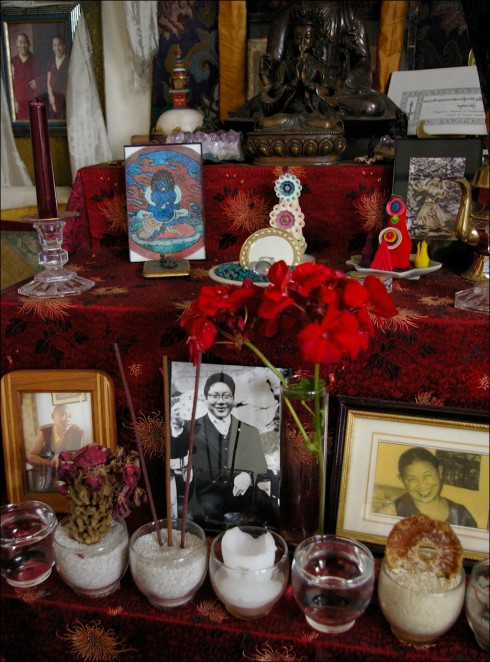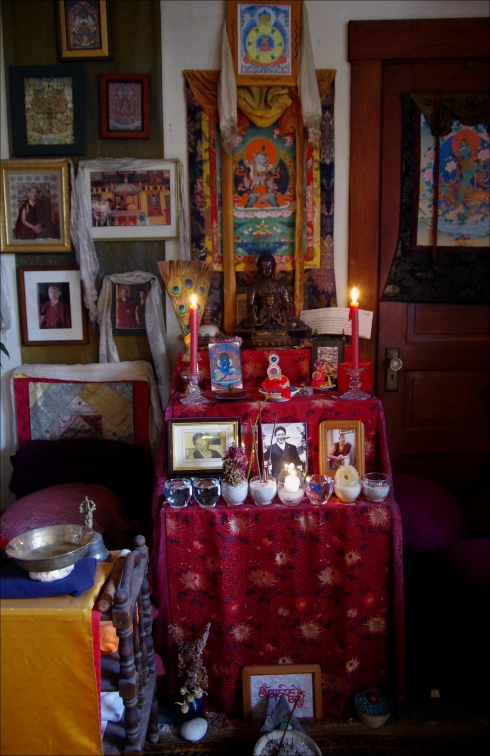You are currently browsing the tag archive for the ‘Buddhist practice’ tag.
Tag Archive
Enshrining your practice with a shrine…
23 December 2013 in Paying Attention, Sadhanas Practices Prayers | Tags: "Tibetan Buddhism", Buddhist practice, Drikung Kagyu, household shrine, Karma Kagyu, shrine, shrine offerings | Leave a comment
While some might argue that it is entirely too formal to create a formal shrine or practice area in one’s home, I suggest that the effect is entirely beneficial.
In a family situation, having a formal area reserved for practice… and going there from time to time… becomes a comfortable signal to other family members. “This is something I do.” Rather than “sneak in” your practice around the edges of your life, opening a shrine and creating a quasi-formal practice environment openly declares to yourself (and others) this is for real.
ThiYour prayers, ngöndro, visualisations and chants need not be just something you do under your breath. And sitting down to meditate in a corner chair… while family traffic flows by or near you… may feel like the only practice you can afford. But often-enough such practice is in danger of being eroded by intercessions from children, shopping list questions from one’s partner, and other matters (including ringing telephones) which seemingly must be responded to. One’s practice becomes the first sacrifice you make to a busy life, and the last to be picked up again after interruption.
Creating a special area in your house or apartment for focussed practice is a gift to yourself, to your teacher and to your practice. Erecting a small or formal shrine table… which you “open” by making offerings as part of your practice… becomes leverage for yet more benefits through attention, intention and action.
What the shrine exactly means is entirely in your own perception. But in general it is a visual and tactile mini-environment containing all the reinforcing symbols which support wherever you are, in your path. Perhaps you can create the formal shrine with a stupa and text symbolising the never-ending presence of Buddha energy & teachings.
Such a shrine may certainly also include a statue (rupa) of the yidam-presence you feel most attracted to, as your idealised means for self-realisation… whether the endless compassionate activities of Chenrezig/Avalokitesvara, the skillful lightning-like rising-to-the-moment of Green Tara, the discriminating cutting-through-the-dross perceptiveness of Manjusri, or the perserverance and unprejudiced open-mindedness of Sakyamuni Buddha himself… as examples.
And you may choose also to include images of favourite teachers, or other exemplars in your order or lineage of Buddhism, or of the invisible protectors whose practices may be part of your promise to yourself and your mentor/lama… your personal samaya.
Your intention, your attention and your good heart are wonderful qualities. There is a phrase in certain Drikung Kagyu texts saying, “I offer this torma.” Torma is an energy being (or representation of such) and your present, fully-attentive self… no matter how limited you might feel sometimes… is a delightful and delighting offering. Your attitude and your care become your offering as you prepare objects to put on your shrine such as water, fresh flowers, or a sample of good food.
The symbolism is to focus your mind upon that which you can contribute… as a sign of gratefulness and humility. So even the simplest offering… which would be 8 (or 7) bowls of clear water… can serve if you aren’t in a position to make up anything “fancy.” Fancy-ness (or exotic-ness) is not the point. Your clarity and gratitude are.

Offerings may be simple or complex, and can become a beacon of genuine appreciation which you engage with every day.
Whatever you offer – either just water in bowls, or a combination of elements including flowers and food – it is best if kept fresh. Doing so can be a very meditative practice in itself… positioning the bowls, replacing the water, and keeping all surfaces clean and items dusted. Avoid “getting casual” about your actions with respect to the shrine – as the prelude to giving focussed attention to your studies and practice.
• • • • • • • • • •
In a future discussion I will try to cover this in greater detail, but for now hopefully you will be inspired to make a shrine in your own household. I also intend to again provide an illustrated guide to the “hand offerings” or mudras.
Important Note: The shrine stand or table, by the way, need not be at all elaborate… and can even be a cardboard box with a piece of flat gypsum board on it. In respect, make every effort to assure that the highest level of your shrine and its rupa statue of a Buddha energy… is higher than the eye level of a person sitting down, either on a cushion or low chair.
May all beings be happy, and know the happiness which is beyond sorrow. And may your practice be fruitful.

